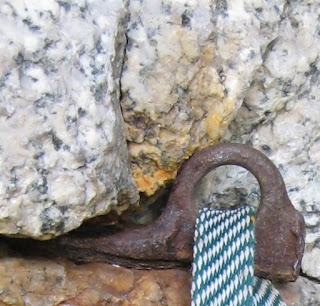 |
| From left to right; Day Needle, Keeler Needle and Mt Whitney's east face. |
|
|
Mt. Whitney is the tallest peak in the lower 48 states. It has two prominent sides that are climbed. There is the surprisingly moderate west side, which offers a long, 22 mile round trip, hiking trail to the top. Then there is the dramatic east side, which is home to more technical climbing. The permit system for hiking or climbing this impressive peak is extremely restrictive, so I was really lucky to obtain a permit the day before I planned on climbing. My plan was to climb from the east side of the mountain, solo, car to car, in a day. Via the mountaineers route. Admittedly, the route I was planning is the easiest technically on the east side (a scramble), but it would be my first time on the route, I would be alone and I would be going for speed, meaning no extra gear. (yes mom I brought my helmet ;) East side routes are most often climbed in two days. One for the approach into the back country/acclimatization, and one for the climb and decent. I needed to moved fast and take care when climbing and route finding. An alpine start was mandatory, so I crawled into my bag with the alarm set for 4:00 am. I had packed my bag the day before so I could throw it on and start moving immediately. When I woke and went down to the "bear box", I found that someone had left the latch open and a bear had ravaged my gear! I repaired my bag with gorilla tape (really quality duck tape) and started to clean up the garbage. As for my food, Yogi ate my breakfast and my lunch. I had a really nice nectarine, so I don't really blame him. Luckily he left me 5 granola bars scattered in the parking lot. I'm not opposed to sharing but come on!! Ok, four liters of water, 5 granola bars, helmet, rainshell, down jacket, ipod, 14,496 feet. Check.
 |
| The scene at 4am. My pack is just out of view with the top torn off... |
After overcoming this little speed bump half asleep, I set out on the trail at exactly 5am. A little late for my liking, but still on track. The route starts on the hikers trail (8,360 ft) and quickly branches off to steeper and more technical terrain. I had spent last week at sea level, so this was going to hurt. Reaching the summit would mean an elevation gain of about 6,136 ft over rough and convoluted terrain. I had set my turn around time for 1:30pm meaning if I wasn't on top by then, I would give up and turn around. It's important to set concrete limits for yourself before setting out into the mountains, and abide by them. This prevents "summit fever" which has been the source of an untimely demise for many climbers. Also, afternoon storms move in quick and without warning.
 |
| Sunrise in the Sierras and a long way to go... |
 |
| Always reserve time for a quick thank you... |
|
|
|
My headlamp guided me through the early sections of the route and as the sun started to rise I became energized by the setting I suddenly found myself in. The interior of the Sierra mountains is spectacular. It is a seemingly endless kingdom of granite spires and rugged beauty, a place I will be sure to return to with a climbing partner for some of the more technical and challenging peaks. Inspired by location, (and the divided sky jam pumping through my headphones) I kicked it into high gear and started to feel the altitude burn my lungs. Much of the difficulty of this route was maintaining motivation, and route finding. However the last few thousand feet were semi technical loose climbing that demanded my complete focus. I stood on the summit at around 10:45 and descended via the same route. I was able to "scree ski" a thousand foot gully which saved me a lot of time, and had me day dreaming about winter. I was back at my truck at around 2:45pm with a headache from a quick decent and dehydration. All said and done the route took about 9hours and 45min. With about 45 of them sitting on top. Although you always feel you could have done something harder, higher, or faster. It is certainly great training for more difficult and remote alpine peaks and is a step in the right direction!

